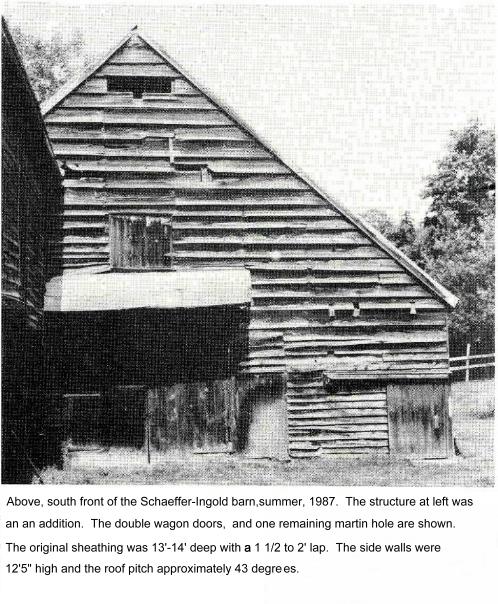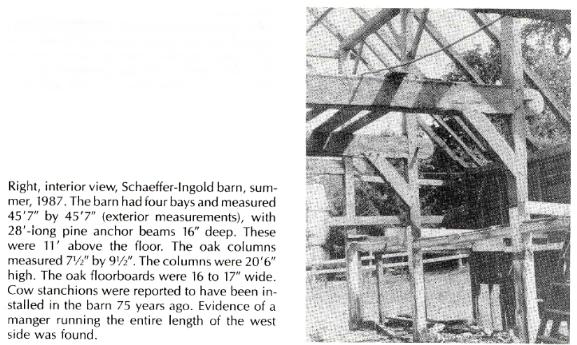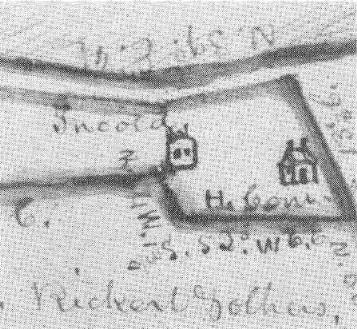|
Dutch
Barn Preservation Society
Dedicated
to the Study and Preservation
of New World Dutch Barns
NEWSLETTER,
SPRING 1998
Volume 1 Issue 1
INAUGURAL
ISSUE
Violent Incident
Dates Schoharie Barn
By Shirley Dunn
 The
Schaeffer-Ingold Barn of Schoharie is of special interest because
there is strong documentary evidence of its age. Dating Dutch
barns has proved to be difficult since the general scheme of
the framing and construction techniques remained the same for
almost two centuries. Although extremely early barns are usually
recognizable, variations between barns can be regional and ethnic
as well as age-related. These variations will be discussed in
future articles. The
Schaeffer-Ingold Barn of Schoharie is of special interest because
there is strong documentary evidence of its age. Dating Dutch
barns has proved to be difficult since the general scheme of
the framing and construction techniques remained the same for
almost two centuries. Although extremely early barns are usually
recognizable, variations between barns can be regional and ethnic
as well as age-related. These variations will be discussed in
future articles.
Historical or documentary sources can be helpful
as alternatives to physical examination in determining the age
of some barns. The Schaeffer-Ingold barn has an especially strong
historical record which suggests it was erected no later than 1780,
and possibly as early as 1753.

The barn was identified in 1845 by historian Jeptha R. Simms
in his History of Schoharie and the Border Wars (pp. 414,
606) as a building which had survived the Revolution and one which
had been used as a summer schoolroom before that war. Simms carefully
noted his oral history sources; the barn survival record came from
a participant in the war and resident of the farm, John Ingold,
a living son of the wartime owner. Maps, deeds, and a nearby structure,
known as the first courthouse (still standing in 1988), make clear
that the John Ingold farm of the eighteenth and nineteenth centuries
is the Paul Schaeffer farm of the mid-twentieth century.
Simms' account of the Brant raid on the Schoharie Valley in 1780
follows:
John Ingold, who dwelt where his son and namesake now resides,
was in the fort that day with all his family except Anthony Witner,
his step-father. As a hostile invasion was expected, the present
John Ingold, then a lad fourteen years old, went the evening
before with a wagon to take old Mr. Witner to the fort, but he
declined going, and said he chose to stay and defend his house.
He had given his grandson an old gun which was then at the fort;
this he requested to have sent to him in the morning. The Ingold
dwelling was burned, and as a part of two skeletons was found
in its ruins, it was conjectured that a plunderer had been killed
by Mr. Witner, before his death. The remains of the latter were
identified by his silver knee-buckles. A barrack filled with
peas, standing scarcely three yards distant from Ingold's barn,
was set on fire and the enemy supposed from its proximity it
would burn the latter; but as the former stood west of the building
and the wind blew a gale from the northeast, the fire was fortunately
not communicated to it. A fence on fire and slowly burning to
the windward, which would have carried the flame to the barn,
was extinguished after the enemy left.
The house associated with the Ingold incident is clearly indicated
on a map of May,  1753,
when the section known as "Fountain Towne" was divided
by consent of the owners, including John Ingold (lncold). See the
accompanying map detail. 1753,
when the section known as "Fountain Towne" was divided
by consent of the owners, including John Ingold (lncold). See the
accompanying map detail.
Since the map legend also mentions the owners' houses, and the
farms seem to have been in operation, there is a strong possibility
that the Ingold barn was already in existence by 1753.
While most barns are not so dramatically recorded, research in
local history books, and tracing the property through maps, deeds
and wills, is recommended for a full understanding of the development
of the farmstead and for clues to a barn's age.
In 1987, the Schaeffer-Ingold barn was purchased from its owner,
Paul Schaeffer, and dismantled by the Schoharie County Historical
Society, which intends to re-erect it on Society property. The
barn was studied by members of the Dutch Barn Preservation Society
shortly before dismantling began.

Acknowledgments: Research assistance for
this article was provided by Helene Farrell, Schoharie County
Historical Society. John R. Bleecker map of the division
of Fountain Town, courtesy Schoharie County Historical Society.
Drawing by Mark Peckham. Photos courtesy Schoharie County
Historical Society. Photo caption notes supplied by Harold
Zoch, Mark Hesler and Vincent Schaefer.
Newsletter Spring
1988, Part TWO
|